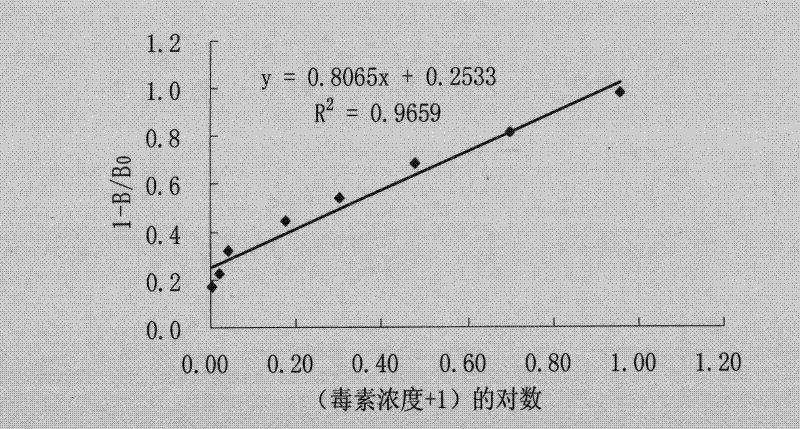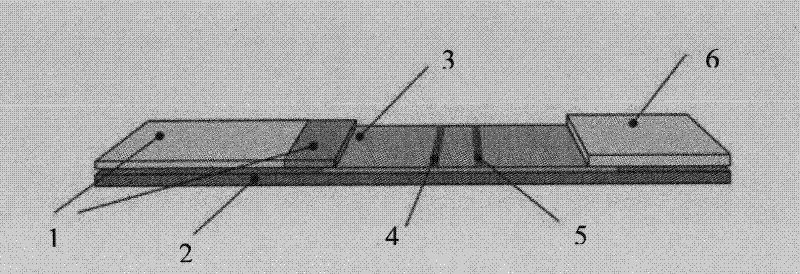Hybridoma cell line and application thereof
A technology of hybridoma cell lines and hybridoma cells, applied in the field of hybridoma cell lines, to achieve good application value, high specificity, and good sensitivity
- Summary
- Abstract
- Description
- Claims
- Application Information
AI Technical Summary
Problems solved by technology
Method used
Image
Examples
preparation example Construction
[0045] 2. Preparation of Hybridoma Cells
[0046] The splenocytes and SP2 / 0 cells of the immunized mice were collected by conventional methods and fused with 50% PEG4000 at a ratio of 10:1. Use HAT culture medium for selective culture, 10-15 days after fusion, take the supernatant and use indirect ELISA method to screen for secretion of anti-FB 1 The positive clones were subcloned by limiting dilution method.
[0047] The operation steps of the indirect ELISA method are as follows: use 2 μg / mL FB 1 -OVA-coated microtiter plate, use immune mouse serum 1:100 as positive control, culture supernatant without clonal growth and normal mouse serum as negative control, add 1:10000 goat anti-mouse IgG-HRP 100 μL to each well, and finally measure 450nm value, where OD 450 If the value is greater than 2 times of the negative control, it can be preliminarily judged as a positive clone.
[0048] 3. Establishment of hybridoma cell lines
[0049] Repeat step 2 for 4 times of cell fusion...
Embodiment 2
[0057] Example 2, Application of 4E10 cell line to prepare anti-FB 1 monoclonal antibody
[0058] 1. Antibody preparation
[0059] Select healthy BALB / C mice, inject 0.5mL pristane intraperitoneally into the mice firstly, and then inject 1×10 hybridoma cells into each mouse intraperitoneally after 7-10 days 6 -2×10 6 After the abdomen of the mouse was significantly enlarged to a certain extent, the ascites was extracted with a No. 9 needle. The collected ascites was centrifuged at 13,000 rpm for 30 min at 4°C, and the supernatant was collected.
[0060] The collected ascites was saturated (NH 4 ) 2 SO 4 The precipitation method was used for purification, and the specific steps were as follows: take the supernatant in the above steps, add an equal volume of PBS buffer, then add an equal volume of acetic acid buffer and 33 μL octanoic acid, and stir magnetically for 30 minutes. Centrifuge at 3000rpm for 30min at 4°C, take the supernatant; add an equal volume of saturated ...
Embodiment 3
[0079] Embodiment 3, using monoclonal antibody for detection kit
[0080] From the above research results, we have developed an immunoassay kit for fumonisin FB1. Since the anti-FB1 monoclonal antibody of the present invention has high sensitivity and stable physical and chemical properties, it can be easily prepared and detected according to standard methods. Toxin kit.
[0081] The following is the specific composition of a detection kit prepared by the present invention utilizing the anti-fumonisin FB1 monoclonal antibody:
[0082] Coating antigen: the conjugate of fumonisin FB1 hapten and hemocyanin KLH, 50 μl / bottle, diluted 3000 times with coating buffer before use;
[0083] Detection antibody: Purified mouse ascites, 100 μl / bottle, diluted 6000 times with PBS buffer and premixed with samples;
[0084] Substrate: Tetramethylbenzidine (TMB), 5mg / bottle;
[0085] HRP-labeled goat anti-mouse IgG: the working concentration is 1:10000, diluted with pH7.4 phosphate buffer for...
PUM
 Login to View More
Login to View More Abstract
Description
Claims
Application Information
 Login to View More
Login to View More - R&D
- Intellectual Property
- Life Sciences
- Materials
- Tech Scout
- Unparalleled Data Quality
- Higher Quality Content
- 60% Fewer Hallucinations
Browse by: Latest US Patents, China's latest patents, Technical Efficacy Thesaurus, Application Domain, Technology Topic, Popular Technical Reports.
© 2025 PatSnap. All rights reserved.Legal|Privacy policy|Modern Slavery Act Transparency Statement|Sitemap|About US| Contact US: help@patsnap.com



